What’s striking about Disney classic character voices is the strong affinity that exists between the artist and the character, almost as if they were the same. Part of this was Walt Disney’s great sense of casting: the bear-like “bonhomie” of Phil Harris (Baloo), the British-girlish quality of Kathryn Beaumont (Alice and Wendy) or the “candor” of Sterling Holloway (Pooh), among many others.
But that kind of perfect match may have never happened in the case of One Hundred and One Dalmatians‘ Anita, and that’s what British turned American actress Lisa Davis, the original voice of Mrs. Roger Radcliff, explains to us…

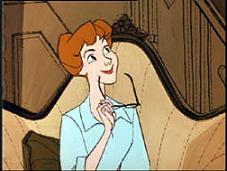 Animated Views: Can you tell me the story of how you became Walt Disney’s Anita?
Animated Views: Can you tell me the story of how you became Walt Disney’s Anita?
Lisa Davis: Walt Disney had originally brought me from England. I was born in London and I grew up in showbusiness in London surrounded incidentally by one very, very famous Frenchman who I spent most of my youth with, called Stéphane Grapelli. It was Django Reinhardt, Stéphane Grapelli and the Hot Club of France. I grew up surrounded by those people. However, Walt Disney brought me from England when I was about twelve to work on another movie that he was planning at that time called Alice in Wonderland. But he didn’t do it the way he originally planned. He was going to do a live Alice and animated the characters around her. So, he sent me back to England, but I made up my mind that I was going to get back to America one day, and sure enough I did.
AV: How did Walt Disney happen to know you as you were in England?
LD: Well, when I was 6 years old, I started working in England in the movies, and when I was about 12, I made a picture for a very great English director whose name is David Lean, who made Lawrence of Arabia and The Bridge on the River Kwai. He made some wonderful movies, and Walt Disney saw me in a movie that I had made for him.
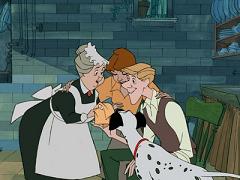 AV: And so, the second time you came to America, you became Anita. How did that happen?
AV: And so, the second time you came to America, you became Anita. How did that happen?
LD: When came back to America, I was under contract with a very big studio called MGM. I did a lot of work in my young years, when I was 15, 16, 17, working in the movie industry and when I was about 20, I did a picture with a crazy Hungarian actress called Sza Sza Gabor. When Mr. Disney first planned One Hundred and One Dalmatians, he was thinking that he would like to have the character of Cruella de Vil speak like Sza Sza Gabor and I had learned how to imitate her during the time I worked with her. He had heard me do that and called me to the Studio to read for the role of Cruella de Vil as the sound of Sza Sza Gabor. As I was sitting with him at a table at the studio, he was reading the role of Anita and I was trying very hard to be Cruella de Vil. But I knew it wasn’t working because I was too young and it wasn’t right. As I heard him read the role of Anita, I knew that I was right for Anita. But how could I possibly tell the great Walt Disney that he had brought me in and had made a mistake? So, I became brave enough to tell him and I said: “excuse me, sir. Would you mind if I try to read the role of Anita? As I’m much more Anita than I am Cruella.” And he said: “No. Let’s try that!” So, we reversed the role. He read Cruella and I read Anita, and indeed I was Anita. And I still feel like Anita all these many years later!
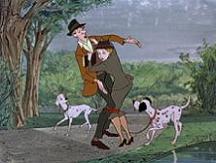 AV: What do you mean?
AV: What do you mean?
LD: Well, at that time, I was 20 years of age, I was a young married lady, I had just got married and Anita got married in the movie, she marries Roger, and we looked alike. If you see still pictures of me at the time and you see Anita on the screen, we are one and the same person. And even though many, many years have passed, when I see the picture, I can see myself in Anita. And I feel like Anita. I’ve remained very, very British. Although I have been in America many years, I still relate to my British roots.
AV: How did the voice recordings go?
LD: The way they worked is that they call you in to the Studio and you go into a very, very large recording studio and all the way around on the walls are little sketches of the movie. They take you and they show you one sketch in particular and it will have a line written on it. For instance: “it’s teatime, Roger. It’s teatime, darling”. And they say: “that’s the line we want to do today. And then you go to the microphone and you read that one line as many different ways as you could possibly think to read it, until they hear what they like. Sometimes, that’s all you do in one day! That’s the way we did it back then. They don’t do it that way now. When they do it today, they do it relatively quickly and the person who’s recording the lines does probably most of them in a short period of time. I worked on One Hundred and One Dalmatians for four years. So, it was a very slow process and when Walt Disney was in charge of the Studio, he really sought perfection. Everything had to be right, even before I started working on the actual movie: he had me come to the Studio for a couple of weeks and just literally play with Dalmatian puppies.
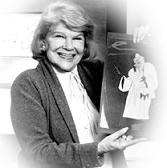 AV: Did you work directly with Betty Lou Gerson [right], who was the voice of Cruella?
AV: Did you work directly with Betty Lou Gerson [right], who was the voice of Cruella?
LD: No, I worked entirely by myself. It was never two characters in the studio at the same time. They cut that together, but I’ve never worked with anybody else, we never got back and forth to each other, although it appears that way on the screen.
AV:Did you happen to meet Anita’s lead animator, Milt Kahl?
LD: Yes. He did watch me during the recordings. In the second DVD of the One Hundred and One Dalmatians Platinum Edition, they tell the story of how we made it and there are pictures of me and then animated on the screen. It shows the similarities between the two characters.
AV: Anita first appears as a kind of a strict person in the movie, while at the end, she’s very warm and enthusiastic. How did you approach that arc?
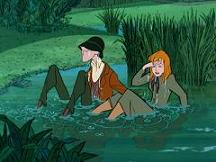 LD: Well, I think that in the beginning, she’s typically a young, British, well-behaved girl. Anita and Roger are meeting in the park and she is not acknowledging that a gentleman is looking at her, I think, until we fall into the pond in Regent’s Park. I think that’s where she starts to soften up, when she starts to laugh. I think it’s just her British reserve and not so much that she’s strict. She’s a reserved, young, British girl being very, very polite and reading her book in the park and trying not to pay attention to the gentleman who is flirting with her. I think, really, that’s what it is.
LD: Well, I think that in the beginning, she’s typically a young, British, well-behaved girl. Anita and Roger are meeting in the park and she is not acknowledging that a gentleman is looking at her, I think, until we fall into the pond in Regent’s Park. I think that’s where she starts to soften up, when she starts to laugh. I think it’s just her British reserve and not so much that she’s strict. She’s a reserved, young, British girl being very, very polite and reading her book in the park and trying not to pay attention to the gentleman who is flirting with her. I think, really, that’s what it is.
AV: What are your memories of Walt Disney from a human point of view?
LD: Walt Disney was absolutely wonderful. He was a very, very kind man. He was always in charge of the production. He was there when you went to lunch in the Studio every day, he would be sitting in the dining room when you were having lunch. You could see him, you could talk with him. He was kind and very approachable. He didn’t hold himself at the top of the Studio. He was very caring. The only thing that he asked was that we do the very, very best that we could and achieve as close to perfection as possible. I think that is why, today, when you look back at all of these wonderful products that he made, they have such a long life because they are as close to perfect as possible. He was a perfectionist.
Our special appreciation to Mrs. Lisa Davis and to Mac McLean for this interview.



